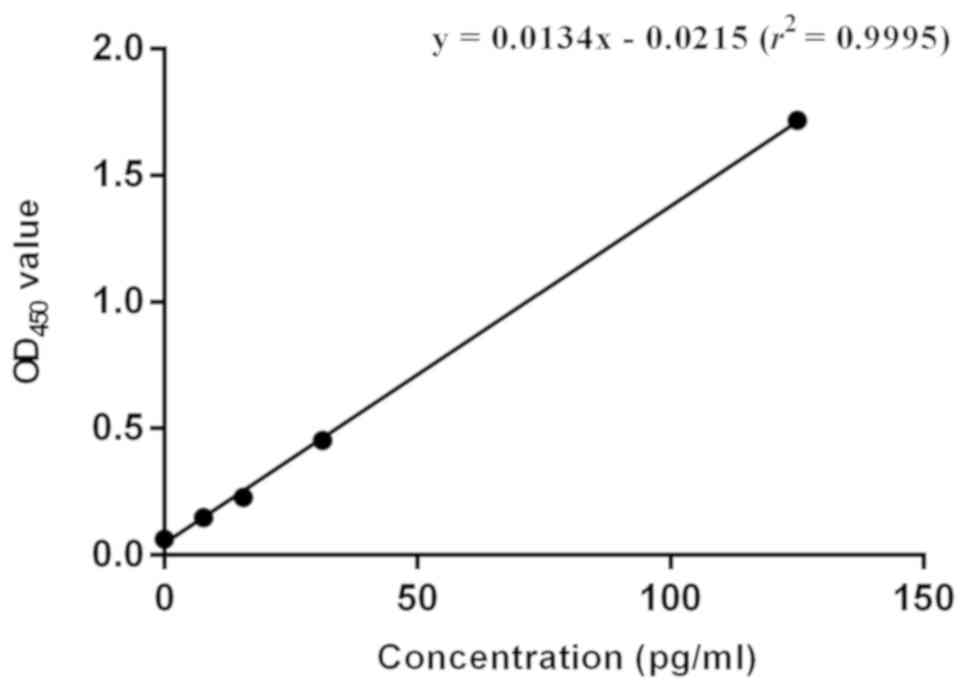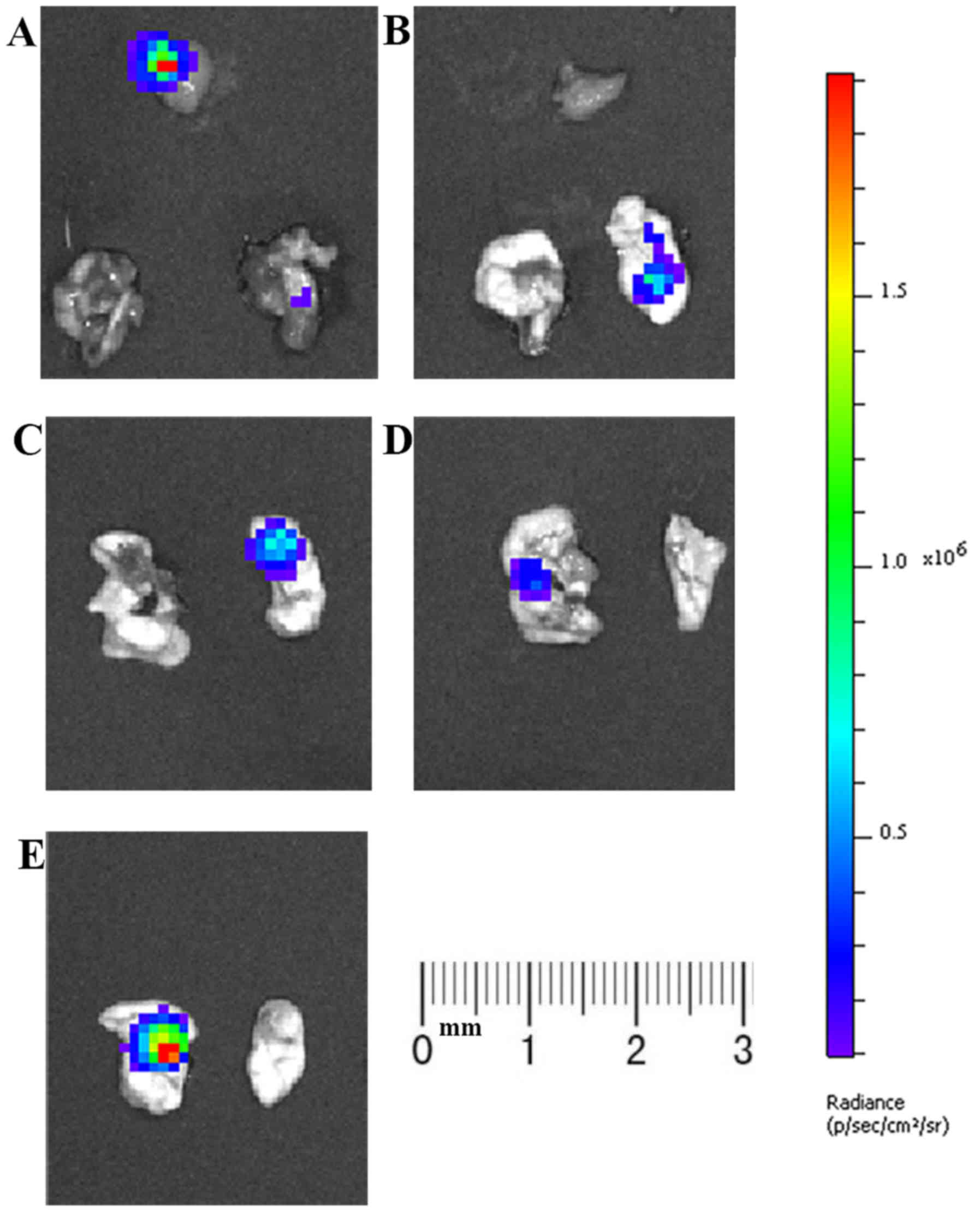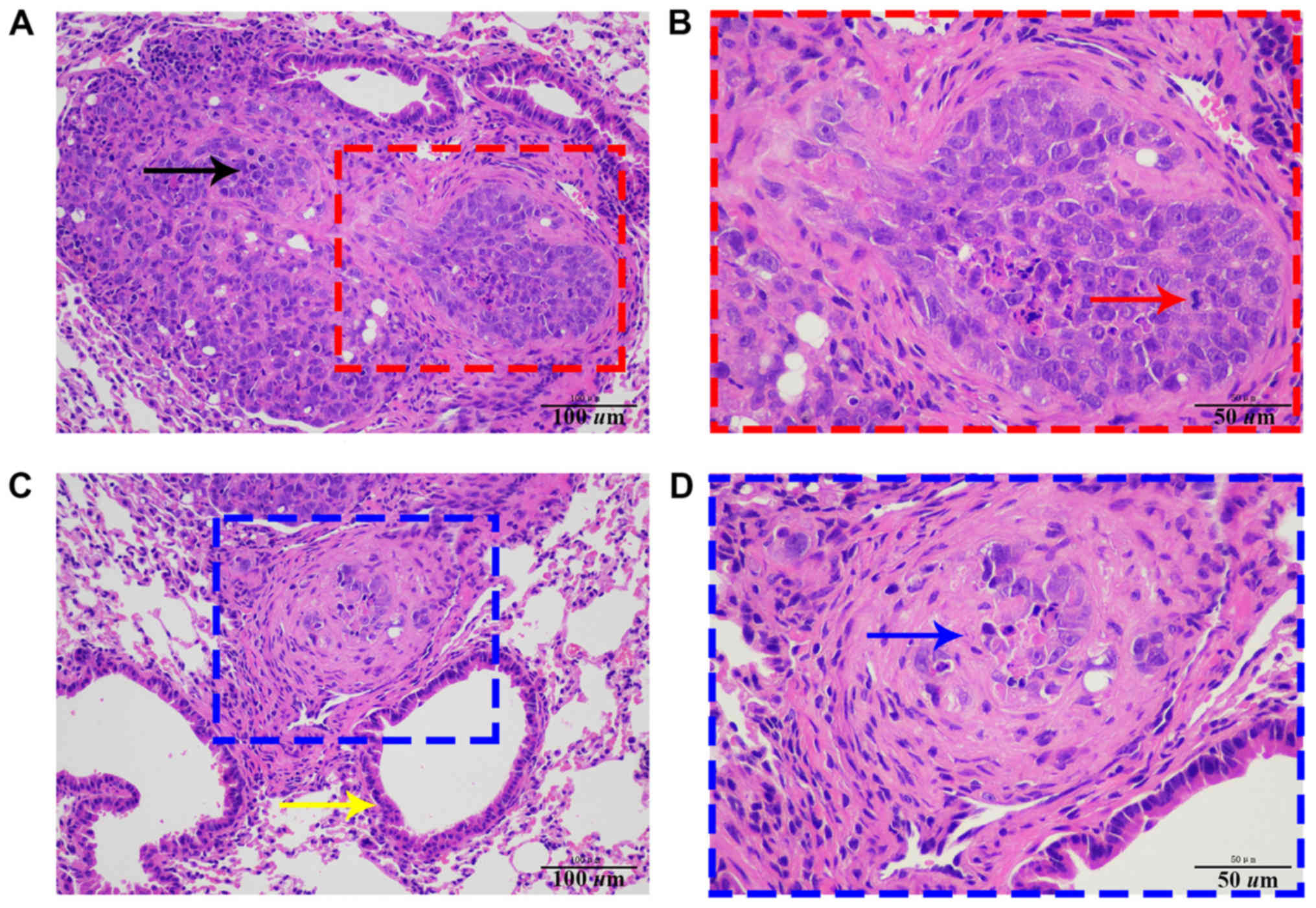|
1
|
Yu Y, Yu X, Fan C, Wang H, Wang R, Feng C
and Guan H: Targeting glutaminase-mediated glutamine dependence in
papillary thyroid cancer. J Mol Med (Berl). 96:777–790. 2018.
View Article : Google Scholar : PubMed/NCBI
|
|
2
|
Hardin H, Helein H, Meyer K, Robertson S,
Zhang R, Zhong W and Lloyd RV: Thyroid cancer stem-like cell
exosomes: Regulation of EMT via transfer of lncRNAs. Lab Invest.
98:1133–1142. 2018. View Article : Google Scholar : PubMed/NCBI
|
|
3
|
Raue F and Frank-Raue K: Thyroid cancer:
Risk-stratified management and individualized therapy. Clin Cancer
Res. 22:5012–5021. 2016. View Article : Google Scholar : PubMed/NCBI
|
|
4
|
Nikitski AV, Rominski SL, Wankhede M,
Kelly LM, Panebianco F, Barila G, Altschuler DL and Nikiforov YE:
Mouse model of poorly differentiated thyroid carcinoma driven by
STRN-ALK fusion. Am J Pathol. 188:2653–2661. 2018. View Article : Google Scholar : PubMed/NCBI
|
|
5
|
Yang J, Li LF, Zhang XM, Xu Q, Zhang J,
Weng WW and Dong MJ: Unusual synchronous skeletal muscle and lung
metastasis in papillary thyroid cancer: A case report and review of
the literature. Oncol Lett. 9:727–730. 2015. View Article : Google Scholar : PubMed/NCBI
|
|
6
|
Bruglia M, Palmonella G, Silvetti F,
Rutigliano P, Criante P, Marmorale C, Boscaro M and Taccaliti A:
Skin and thigh muscle metastasis from papillary thyroid cancer.
Singapore Med J. 50:e61–e64. 2009.PubMed/NCBI
|
|
7
|
Luo Q, Luo QY, Sheng SW, Chen LB, Yu YL,
Lu HK and Zhu RS: Localization of concomitant metastases to kidney
and erector spinae from papillary thyroid carcinoma using
(131)I-SPECT and CT. Thyroid. 18:663–664. 2008. View Article : Google Scholar : PubMed/NCBI
|
|
8
|
American Thyroid Association (ATA)
Guidelines Taskforce on Thyroid Nodules and Differentiated Thyroid
Cancer, ; Cooper DS, Doherty GM, Haugen BR, Kloos RT, Lee SL,
Mandel SJ, Mazzaferri EL, McIver B, Pacini F, et al: Revised
American Thyroid Association management guidelines for patients
with thyroid nodules and differentiated thyroid cancer. Thyroid.
19:1167–1214. 2009. View Article : Google Scholar : PubMed/NCBI
|
|
9
|
Park SJ, Jang HR, Kim M, Kim JH, Kwon OH,
Park JL, Noh SM, Song KS, Kim SY, Kim YH and Kim YS: Epigenetic
alteration of CCDC67 and its tumor suppressor function in gastric
cancer. Carcinogenesis. 33:1494–1501. 2012. View Article : Google Scholar : PubMed/NCBI
|
|
10
|
Yu YP, Ding Y, Chen Z, Liu S,
Michalopoulos A, Chen R, Gulzar ZG, Yang B, Cieply KM, Luvison A,
et al: Novel fusion transcripts associate with progressive prostate
cancer. Am J Pathol. 184:2840–2849. 2014. View Article : Google Scholar : PubMed/NCBI
|
|
11
|
Chen ZH, Yu YP, Zuo ZH, Nelson JB,
Michalopoulos GK, Monga S, Liu S, Tseng G and Luo JH: Targeting
genomic rearrangements in tumor cells through Cas9-mediated
insertion of a suicide gene. Nat Biotechnol. 35:543–550. 2017.
View Article : Google Scholar : PubMed/NCBI
|
|
12
|
Yin DT, Xu J, Lei M, Li H, Wang Y, Liu Z,
Zhou Y and Xing M: Characterization of the novel tumor-suppressor
gene CCDC67 in papillary thyroid carcinoma. Oncotarget.
7:5830–5841. 2016.PubMed/NCBI
|
|
13
|
Sekiguchi Y, Owada J, Oishi H, Katsumata
T, Ikeda K, Kudo T and Takahashi S: Noninvasive monitoring of
β-cell mass and fetal β-cell genesis in mice using bioluminescence
imaging. Exp Anim. 61:445–451. 2012. View Article : Google Scholar : PubMed/NCBI
|
|
14
|
Tu SH, Hsieh YC, Huang LC, Lin CY, Hsu KW,
Hsieh WS, Chi WM and Lee CH: A rapid and quantitative method to
detect human circulating tumor cells in a preclinical animal model.
BMC Cancer. 17:4402017. View Article : Google Scholar : PubMed/NCBI
|
|
15
|
Feng L, Jia X, Zhu M, Chen Y and Shi F:
Chemoprevention by Prunella vulgaris L. extract of non-small cell
lung cancer via promoting apoptosis and regulating the cell cycle.
Asian Pac J Cancer Prev. 11:1355–1358. 2010.PubMed/NCBI
|
|
16
|
Kato H, Wakabayashi H, Naito Y, Kato S,
Nakagawa T, Matsumine A and Sudo A: Anti-tumor necrosis factor
therapy inhibits lung metastasis in an osteosarcoma cell line.
Oncology. 88:139–146. 2015. View Article : Google Scholar : PubMed/NCBI
|
|
17
|
Boivin GP, Bottomley MA, Schiml PA, Goss L
and Grobe N: Physiologic, behavioral, and histologic responses to
various euthanasia methods in C57BL/6NTac male mice. J Am Assoc Lab
Anim Sci. 56:69–78. 2017.PubMed/NCBI
|
|
18
|
Randle RW, Balentine CJ, Leverson GE,
Havlena JA, Sippel RS, Schneider DF and Pitt SC: Trends in the
presentation, treatment, and survival of patients with medullary
thyroid cancer over the past 30 years. Surgery. 161:137–146. 2017.
View Article : Google Scholar : PubMed/NCBI
|
|
19
|
Pstrag N, Ziemnicka K, Bluyssen H and
Wesoły J: Thyroid cancers of follicular origin in a genomic light:
In-depth overview of common and unique molecular marker candidates.
Mol Cancer. 17:1162018. View Article : Google Scholar : PubMed/NCBI
|
|
20
|
Bath SC, Pop VJ, Furmidge-Owen VL, Broeren
MA and Rayman MP: Thyroglobulin as a functional biomarker of iodine
status in a cohort study of pregnant women in the United Kingdom.
Thyroid. 27:426–433. 2017. View Article : Google Scholar : PubMed/NCBI
|
|
21
|
Xing M: BRAF mutation in thyroid cancer.
Endocr Relat Cancer. 12:245–262. 2005. View Article : Google Scholar : PubMed/NCBI
|
|
22
|
Liu X, Bishop J, Shan Y, Pai S, Liu D,
Murugan AK, Sun H, El-Naggar AK and Xing M: Highly prevalent TERT
promoter mutations in aggressive thyroid cancers. Endocr Relat
Cancer. 20:603–610. 2013. View Article : Google Scholar : PubMed/NCBI
|
|
23
|
Basolo F, Pisaturo F, Pollina LE,
Fontanini G, Elisei R, Molinaro E, Iacconi P, Miccoli P and Pacini
F: N-ras mutation in poorly differentiated thyroid carcinomas:
Correlation with bone metastases and inverse correlation to
thyroglobulin expression. Thyroid. 10:19–23. 2000. View Article : Google Scholar : PubMed/NCBI
|
|
24
|
Dwight T, Thoppe SR, Foukakis T, Lui WO,
Wallin G, Höög A, Frisk T, Larsson C and Zedenius J: Involvement of
the PAX8/peroxisome proliferator-activated receptor gamma
rearrangement in follicular thyroid tumors. J Clin Endocrinol
Metab. 88:4440–4445. 2003. View Article : Google Scholar : PubMed/NCBI
|
|
25
|
Marini F, Falchetti A, Del Monte F,
Carbonell Sala S, Tognarini I, Luzi E and Brandi ML: Multiple
endocrine neoplasia type 2. Orphanet J Rare Dis. 1:452006.
View Article : Google Scholar : PubMed/NCBI
|
|
26
|
Zhang Y, Wang S, Hu B, Zhao F, Xiang P, Ji
D, Chen F, Liu X, Yang F, Wu Y, et al: Direct detection of
Helicobacter pylori in biopsy specimens using a
high-throughput multiple genetic detection system. Future
Microbiol. 11:1521–1534. 2016. View Article : Google Scholar : PubMed/NCBI
|
|
27
|
Cheng L, Du C, Murray D, Tong X, Zhang YA,
Chen BP and Hawley RG: A GFP reporter system to assess gene
transfer and expression in human hematopoietic progenitor cells.
Gene Ther. 4:1013–1022. 1997. View Article : Google Scholar : PubMed/NCBI
|
|
28
|
Fischer M, Haase I, Simmeth E, Gerisch G
and Müller-Taubenberger A: A brilliant monomeric red fluorescent
protein to visualize cytoskeleton dynamics in Dictyostelium.
FEBS Lett. 577:227–232. 2004. View Article : Google Scholar : PubMed/NCBI
|
|
29
|
Kao TH, Chen Y, Pai CH, Chang MC and Wang
AH: Structure of a NADPH-dependent blue fluorescent protein
revealed the unique role of Gly176 on the fluorescence enhancement.
J Struct Biol. 174:485–493. 2011. View Article : Google Scholar : PubMed/NCBI
|
|
30
|
Cissell KA, Rahimi Y, Shrestha S, Hunt EA
and Deo SK: Bioluminescence-based detection of microRNA, miR21 in
breast cancer cells. Anal Chem. 80:2319–2325. 2008. View Article : Google Scholar : PubMed/NCBI
|


















